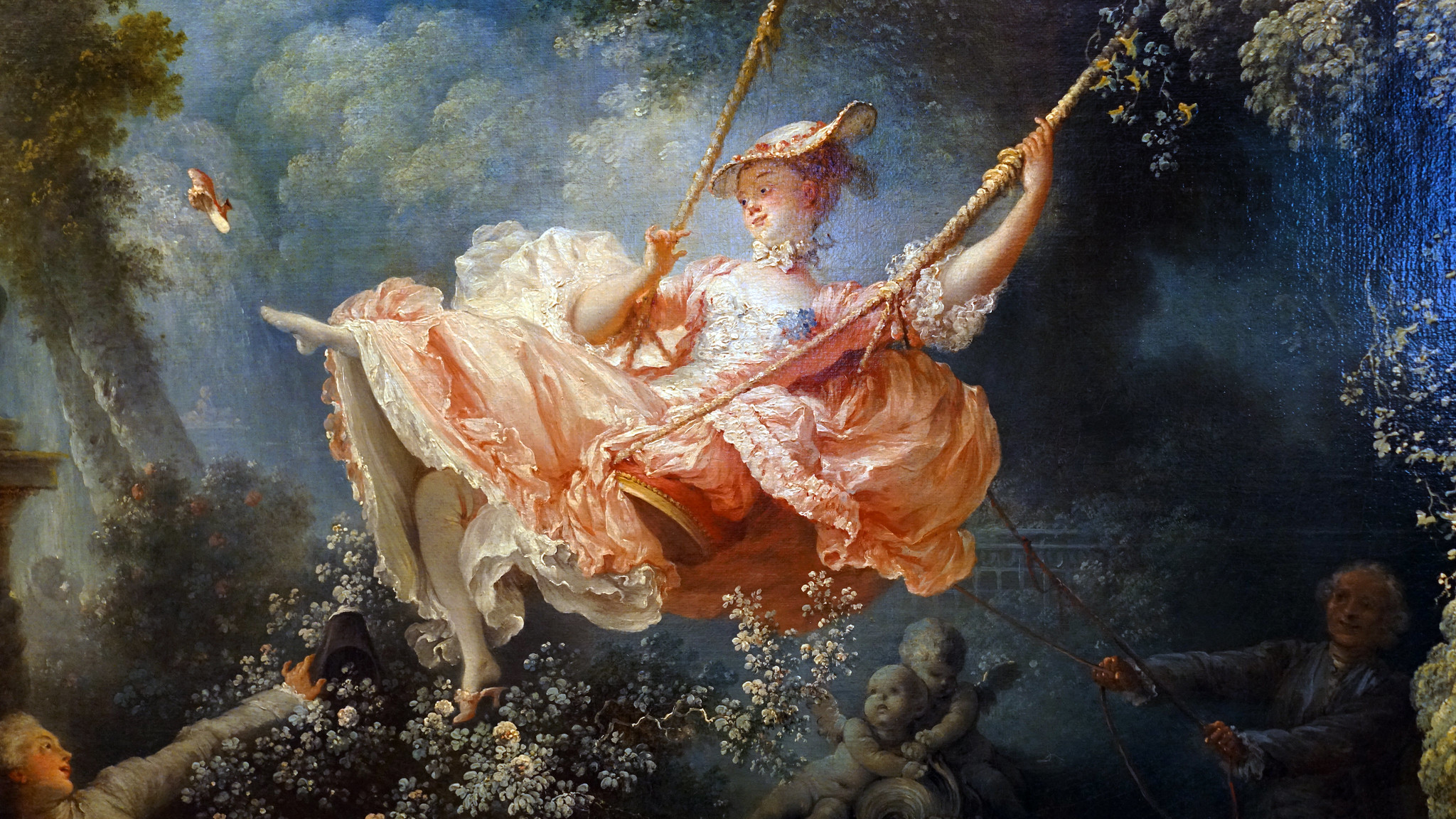
Jean-Honoré Fragonard’s masterpiece, ‘The Swing,’ painted in 1767, stands as an iconic representation of the Rococo era, a period characterized by its ornate and playful artistry. This oil-on-canvas creation, measuring approximately 81 cm × 64 cm, unfolds a whimsical scene set in a lush garden, capturing a fleeting moment of flirtation and indulgence. Commissioned by the French aristocrat Baron de Saint-Julien, the painting weaves together intricate details, subtle eroticism, and a vibrant color palette. As we delve into the historical tapestry of ‘The Swing,’ we uncover its artistic influences, critical reception, and lasting impact on both the art world and popular culture.
Artist: Jean-Honoré Fragonard, a prominent French Rococo painter, created “The Swing” in 1767 during the height of the Rococo movement. This period was characterized by a departure from the formality and grandiosity of the preceding Baroque era, embracing instead a more ornate, playful, and lighthearted style.
Medium: Executed as an oil painting on canvas, “The Swing” showcases Fragonard’s mastery in manipulating pigments and textures. The medium allowed him to convey the richness of the garden scene, capturing the interplay of light and shadow on the figures and foliage.
Location: The Wallace Collection in London, England, is the current home of “The Swing.” The museum, established in 1897, is renowned for its extensive collection of European fine and decorative arts from the 15th to the 19th centuries.
Commissioned Work: Baron de Saint-Julien, a French aristocrat, commissioned Fragonard to create “The Swing.” The work reflects the patronage system prevalent during the 18th century, where wealthy individuals would commission artists to produce pieces tailored to their taste and social status.
Setting: “The Swing” unfolds in an idyllic garden setting. The meticulous rendering of the landscape and the strategic placement of the swing contribute to the overall charm and visual appeal of the composition.
Subject: The painting’s subject is a young woman enjoying a carefree swing while an attentive gentleman lurks in the shadows below. The narrative captures a moment of flirtation and suggests a playful, perhaps clandestine, romantic encounter.
Hidden Lover: The concealed lover in the painting adds an element of mystery and voyeurism. This subtle eroticism aligns with the Rococo fascination for themes of love, courtship, and the pleasures of life.
Rococo Style: “The Swing” epitomizes the Rococo style, known for its emphasis on asymmetry, pastel color palettes, and intricate ornamentation. Fragonard’s work reflects the movement’s focus on capturing the lighter aspects of life and rejecting the rigidity of the Baroque.
Erotic Undertones: The painting’s erotic undertones are evident in the woman’s playful gesture of kicking off her shoe, a symbolic act suggestive of flirtation and sensuality. This subtle eroticism was a characteristic feature of Rococo art.
Color Palette: Fragonard’s vibrant color palette in “The Swing” is characteristic of Rococo aesthetics. Soft pastel tones dominate the canvas, contributing to the overall lightness and delicacy of the composition. The carefully chosen colors enhance the atmosphere of the garden scene and evoke a sense of enchantment.
Influence of Boucher: Jean-Honoré Fragonard’s artistic development was significantly influenced by his teacher, François Boucher, a leading Rococo artist of the time. Boucher’s impact is evident in Fragonard’s embrace of the Rococo style, characterized by its ornate details, love of nature, and playful themes. Boucher’s tutelage laid the foundation for Fragonard’s own artistic expression, as seen in the elaborate yet graceful elements of “The Swing.”
Rivalry with Diderot: Fragonard faced criticism from Denis Diderot, a prominent Enlightenment philosopher and art critic. Diderot expressed reservations about Fragonard’s style, believing it lacked the moral seriousness he deemed necessary in art. This critique reflects the broader debate during the Enlightenment era about the role of art in society and its moral responsibility.
Fragonard’s Reputation: Despite Diderot’s criticisms, Fragonard’s reputation as an artist continued to grow. He became one of the leading painters of the time, known for his Rococo masterpieces. Fragonard’s ability to capture the essence of the era’s spirit contributed to his enduring legacy in art history.
Ownership History: “The Swing” changed hands multiple times before finding its place in the Wallace Collection. The varied ownership adds to the painting’s historical narrative, revealing the evolving tastes and preferences of different collectors throughout the years.
Cultural Impact: “The Swing” has left an indelible mark on the cultural landscape, becoming an iconic representation of the Rococo era. Its influence extends beyond the art world, with the painting often referenced in discussions about 18th-century French society, culture, and aesthetics.
Reproductions: The image of “The Swing” has been widely reproduced in various forms of media, from art prints to advertisements. Its enduring popularity attests to the timeless allure of Fragonard’s composition and its ability to resonate with audiences across different generations.
Legacy: “The Swing” stands as a prime example of the carefree and indulgent spirit of pre-revolutionary France. Its legacy extends beyond its initial creation, providing insights into the social and cultural milieu of the 18th century.
Rococo’s Decline: The French Revolution marked the decline of the Rococo style, as it became associated with the aristocracy and the excesses of the ancien régime. The revolutionary period ushered in a shift towards Neoclassicism, emphasizing reason, order, and simplicity in art.
Restoration: Over the years, “The Swing” underwent careful restoration efforts to preserve its artistic integrity. Restoration work ensures that the painting maintains its original vibrancy, allowing present and future audiences to appreciate Fragonard’s skill and vision.
Exhibitions: “The Swing” has been featured in various art exhibitions worldwide, showcasing its importance in art history. These exhibitions provide opportunities for art enthusiasts to engage with and appreciate the painting in diverse cultural contexts.
Critical Reception: Modern art critics have reevaluated “The Swing,” acknowledging its artistic merit and its significant contribution to the Rococo movement. While initial critiques, such as Diderot’s, focused on moral concerns, contemporary scholars appreciate the painting for its technical prowess, narrative complexity, and its role in capturing the zeitgeist of 18th-century France.
Symbolism: The swing in “The Swing” serves as a symbolic element, representing the frivolity and indulgence of the Rococo era. The act of swinging, coupled with the hidden lover and the woman’s playful demeanor, encapsulates the carefree spirit of pre-revolutionary France and the pursuit of pleasure.
Adaptations: “The Swing” has inspired various adaptations across different art forms, including literature, music, and popular culture. Its visual richness and narrative allure continue to resonate, influencing creators who reinterpret and reimagine the themes presented in the painting.
Educational Tool: Art historians frequently use “The Swing” as an educational tool to teach about Rococo art and its cultural context. The painting provides a visual entry point for discussions about the societal values, aesthetics, and dynamics of 18th-century France.
Cultural Tourism: The Wallace Collection, where “The Swing” is displayed, has become a cultural landmark attracting art enthusiasts and tourists from around the world. The painting’s presence in the collection contributes to the museum’s significance as a repository of European fine and decorative arts, allowing visitors to immerse themselves in the historical and artistic richness of the Rococo period.









